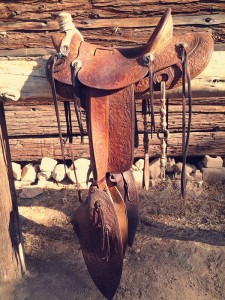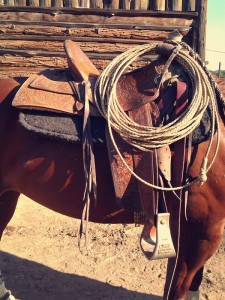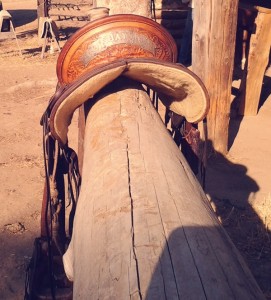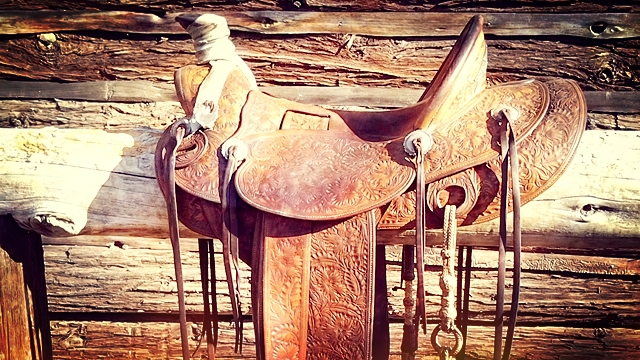Editor’s Note: In issues 72, 73 and 75 the late Jay Harney spoke with Tom Moates, looking back over his life in the saddle, sharing his history and experiences. The following is a related piece in which saddle maker Ron Butler discusses the saddles he made for Jay.
“I met Jay over 30 years ago,” says saddlemaker Ron Butler.
 “He brought a saddle to my shop. He bought used saddles, you know, typical cowboy was switching saddles and buying used stuff. I worked on things and got to know Jay day-working with him here and there. And he brought me a saddle that had been made in Nevada. It had a real low flat seat. He told me that he liked the seat in that particular saddle better than anything he’d been riding. I told him, ‘Well, I’ll build you a seat just like it.’”
“He brought a saddle to my shop. He bought used saddles, you know, typical cowboy was switching saddles and buying used stuff. I worked on things and got to know Jay day-working with him here and there. And he brought me a saddle that had been made in Nevada. It had a real low flat seat. He told me that he liked the seat in that particular saddle better than anything he’d been riding. I told him, ‘Well, I’ll build you a seat just like it.’”
Ron not only built him a saddle with just that kind of seat, but he has built Jay 5 saddles sporting that topside. For nearly three decades Ron has specialized in making hand-crafted, top-quality, custom saddles and leather goods for many working California cowboys. Today he runs Butler Saddle Shop in Jamestown, California, with his wife, Cheryl, and daughter, Sarah.
Aside from the custom seats, the rest of these saddles are equally noteworthy and a bit unusual these days, too. Jay mentioned in his interview that he rides a slick fork saddle with a 3B tree. The 3B is a legendary saddle tree developed by the Visalia Stock Saddle Company. Since Ron built Jay’s saddles, there’s no one better to explain about the features that went into them, including the trees.
 “When we say ‘Visalia,’ that was the most popular, high-quality saddle made in California since the 1870s,” Ron explains. “I built the saddle for Jay and he was really tickled with it. It was on a handmade tree of the 3B style. According to Griff Durham, who’s a Visalia historian from Reno, Nevada, there was also a 3A and a 3C fork style that I’d never heard of, but the 3B was the one that lasted and was popular. Most major saddleries when you look back prior to the Depression and then shortly after—you had Porter’s down in Phoenix, Visalia here, Hamley’s up in Pendleton, Oregon, there was the Miles City, Montana saddleries…down in Colorado you had Heiser’s and Frazier’s, and these are just the biggest ones—all of those saddle companies offered the ‘3B Visalia,’ or their ‘Improved Visalia,’ fork as they called it a lot, just as Visalia, Hamley’s, and the rest would offer the White River or other popular models from the Midwest and up north. They were there to please; they were going to build you whatever you thought you wanted.”
“When we say ‘Visalia,’ that was the most popular, high-quality saddle made in California since the 1870s,” Ron explains. “I built the saddle for Jay and he was really tickled with it. It was on a handmade tree of the 3B style. According to Griff Durham, who’s a Visalia historian from Reno, Nevada, there was also a 3A and a 3C fork style that I’d never heard of, but the 3B was the one that lasted and was popular. Most major saddleries when you look back prior to the Depression and then shortly after—you had Porter’s down in Phoenix, Visalia here, Hamley’s up in Pendleton, Oregon, there was the Miles City, Montana saddleries…down in Colorado you had Heiser’s and Frazier’s, and these are just the biggest ones—all of those saddle companies offered the ‘3B Visalia,’ or their ‘Improved Visalia,’ fork as they called it a lot, just as Visalia, Hamley’s, and the rest would offer the White River or other popular models from the Midwest and up north. They were there to please; they were going to build you whatever you thought you wanted.”
For a more general, in depth overview of saddle trees visit the online exclusive, “Elements of the Saddle Part 1: The Tree” from E-H #12
“The 3B stood the test of time and traveled all across the western United States,” Ron continues. “But, there’s small variations between different tree makers in the actual fork. The 3B is typically 3 ½ to 3 ¾ inches in width and a 3B is generally 8 inches high. Jay’s we cut 7 ¾—in between the typical 7 ½ Wade and an 8-inch 3B. If you set a saddle tree with no leather on it on a flat surface, you measure from the rock, or the top of the table, up to the center of the lip in the front of the fork.
“In California, working with the reata, these men weren’t going to jerk big ones upside down, but they sure did in Texas and the southwest and even in Montana as the Texas cattle went north. On one side of the mountain there’d be California-style vaqueros and buckaroos and on the other side would be tied hard Texans at periods of time in our history.
 “If you looked at Jay’s saddle, there is an inch and a half of leather from the wool to your leg. The stirrup leathers are about an eighth of an inch, and they’re twice around the bar—they’re called ¾ double stirrup leathers. Then the fender itself and the seat jockey—there’s a lot of leather there. I was always concerned about that…it puts a bit of bulk there. Jay said, ‘I don’t notice it. I have no problem with it whatsoever.’ He liked the old-time type.
“If you looked at Jay’s saddle, there is an inch and a half of leather from the wool to your leg. The stirrup leathers are about an eighth of an inch, and they’re twice around the bar—they’re called ¾ double stirrup leathers. Then the fender itself and the seat jockey—there’s a lot of leather there. I was always concerned about that…it puts a bit of bulk there. Jay said, ‘I don’t notice it. I have no problem with it whatsoever.’ He liked the old-time type.
“On the 1923 Visalia, he asked me if I’d make one like this [one he saw in the Visalia catalog from that year]. I said, ‘Yeah, just tell me what page it’s on and what the number is because I’ve got the catalog.’ I made the saddle as close as I could get by using a magnifying glass and seeing the type of stamping it had in it, etc. I could get the stamping pretty correct to what was on that particular saddle
“Jay wanted the older style. The rigging is farther back than virtually anybody rides them nowadays. The old-timers might have a center fire…today you’ll have quite a few ¾. Most everything is 7/8 or full double, on roping saddles in particular. Jay wanted 5/8—one of his saddles is 5/8 rigged, the rest of them are ¾—so we slid it on back there. Basically Jay wanted an old-time-looking saddle that is modern, that is made with what we have today. I’m kind of a purist: I use the same linen threads, I have the same Dextran glue to go in the ground seat. I use the glues the same way the old-timers did it.”
When asked how Ron would describe the saddles he built Jay, he says they are a “California-style saddle.”
 “The California saddles were a little different in the style, the carving, a lot of it was the weight,” Ron says. “They used a lightweight leather and lined them—not every one, but the majority of them—so they were doubled and sewed, long tapaderos were pretty common, single-rigged saddles were pretty common. They were reata ropers.
“The California saddles were a little different in the style, the carving, a lot of it was the weight,” Ron says. “They used a lightweight leather and lined them—not every one, but the majority of them—so they were doubled and sewed, long tapaderos were pretty common, single-rigged saddles were pretty common. They were reata ropers.
“[In the tooling, there is] a variation of the ‘wild rose.’ It’s kind of a ragged-looking wild rose, not round lobed, and Jay loved that so he had me make two with that particular flower. And it was time-consuming—pretty tiny. Basically there’s about 105 flowers on the saddle, and on the tapaderos there will be 18 or 21 flowers on there. It [Jay’s saddles] has a little different cantle than the majority of saddles. It’s got what they call a ‘shovel cantle.’ It’s narrower from side-to-side—11 ½ inches I believe, on Jay’s. They’re made by Midway Saddle Tree in Utah. All of those trees in his saddles are on Midway trees, they have shovel cantles on them, 3b split forks, and after the first one, they all have ¾ double stirrup leathers, which means twice over the bar and they lace—there’s no buckles—they lace through holes at the top of the fender up under the seat jockey, and they’re set with a twist. They’re just old-fashioned period-type saddles on modern saddle trees and with the materials we have available today.”
Butler Saddle Shop
14000 Twist Road
Jamestown, CA 95327
(209) 984-3036


